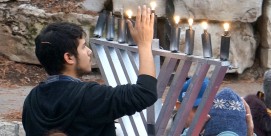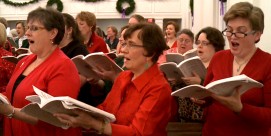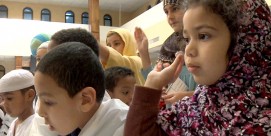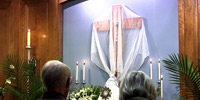Nativity Scene Tradition
BOB ABERNETHY, anchor: Finally, a special holiday report. During the Christmas season, many places around the world have a long-standing tradition of displaying manger scenes, or crèches, that depict the birth of Jesus. Here in the United States, the nativity scene tradition has often been one of church-state controversies over public crèche displays. But apart from controversy, there is an active and growing movement to promote the crèche tradition. Once again, Kim Lawton.
KIM LAWTON: Every Christmas season, Jim Govan of Arlington, Virginia pulls out the nativity scenes for his annual display. He has hundreds to choose from. It has become bittersweet since the death of his wife, Emilia, last year. The couple began their collection shortly after their marriage in 1962, when they bought a crèche for their first Christmas together. A few years later, they picked up another set, and then they were tempted by yet one more.
JIM GOVAN: I’m not sure which one said what to the other, but one certainly said, “What do we do with a third one?” and the other one said, “Well, we could collect them.” And so that was sort of the seed that began it. We began collecting slowly after that time, and then the activity just sort of built up on its own steam.
LAWTON: Today, Govan owns more than 300 nativities — and he’s still adding to the collection.
Mr. GOVAN: It’s sort of become like the nursery rhyme, the old lady in the shoe who had so many children, she didn’t know what to do. I’m not sure I can keep track of them all now.
LAWTON: Govan believes his crèches are meant to be shared. He has lent 43 scenes from 36 countries to Washington’s Pope John Paul II Cultural Center for a special Christmas exhibition.
Govan is part of a growing national movement that seeks to promote the nativity scene tradition in the United States. He is president of Friends of the Crèche, a new society formed last year. The group held its first convention in Lancaster, Pennsylvania last month.
RITA BOCHER (Convention Chair, Friends of the Crèche): It’s a national organization of people who collect crèches, make crèches, or are just interested in the Christmas nativity tradition.
LAWTON: The interdenominational group keeps in touch through the Internet. Its CRECHE HERALD newsletter has more than 600 subscribers around the world.
Manger scenes embody the Christian doctrine of the Incarnation, the teaching that Jesus Christ was God in human form. Many believe the centuries-old crèche tradition has found new appeal in an age so focused on the visual.
Father JOHANN ROTEN (University of Dayton, Marian Research Institute): Yes, we have ears to listen, but we also have eyes to see, and the complete message of the Incarnate God is something that appeals to all of our senses.
LAWTON: Interest in the circumstances of Jesus’ birth stretches back to the earliest days of Christianity, when pilgrims began visiting Bethlehem. The crèche tradition appears to have evolved gradually over the centuries. The birth of Jesus, as described in the Gospels, was depicted in early icons and other religious art. In medieval times, the nativity story was enacted on traveling wagons as part of religious dramas about the life of Jesus.
St. Francis of Assisi is credited with popularizing the crèche tradition. In a candlelit Christmas Eve service in 1223, he staged his own simple reenactment of Jesus’ birth, focusing on the manger.
Father ROTEN: I think that the major role of St. Francis was to make it really come alive.
LAWTON: The idea caught on, first in churches, monasteries, and convents, then in private homes. The manger scenes became more elaborate and took on different cultural characteristics as they moved from Italy to France, Germany, and Spain. Colonists and missionaries spread the nativity tradition even farther.
Mr. GOVAN: It’s simply taken root around the world, and it has its expression in almost every culture around the globe. They take the Christ child to them and reflect it in their own understanding, their own tradition, their own culture.
LAWTON: Jim Govan’s nativities span a vast mix of cultures. He worked for nearly 40 years at the Agency for International Development and picked up numerous nativities during his travels, particularly in Africa.
There are nativity scenes of wool and wood, paper and plastic, brass and glass. They come from Poland and Polynesia and Peru. There’s a Venezuelan leaf nativity and a set from the VeggieTales cartoon. There are the spectacular, such as the Miracle of Christmas living nativity in Lancaster, Pennsylvania, and the miniature, such as this nativity, carved on the end of a matchstick.
One of the largest crèche collections in the United States is here in Dayton, Ohio. The Marian Library at the University of Dayton has more than 900 scenes from all over the world.
Father Johann Roten directs the Marian Research Institute there. He says nativity scenes show the universality of Christianity.
Father ROTEN: If the Incarnation is incarnation, meaning it goes all the way down to the roots of humanity and human life and life in general, then it should become cultural and have different expressions in different cultures.
LAWTON: Here in the United States, nativities are finding American expression. Jim Govan commissioned this set from Navajo woodcarver Felix Yazzie.
Architect David Doelp is erecting his own nativity stable, down to the most minute detail.
Father Richard Cannuli, a liturgical vestment maker, is creating his own elaborate nativity set, using scraps of material from his trade.
Crèche exhibitions are taking place across the country this holiday season, demonstrating the growing vibrancy of the tradition here. People are attracted by the art and the beauty, but many Christians say they are also touched by the ultimate message of the scenes.
Father ROTEN: If God becomes one of us, if God becomes one of the citizens of this world, very definitely the Incarnation is something where God meets the human person where that human person is.
LAWTON: And Christians say, in a fragile world, that message is more relevant than ever.







